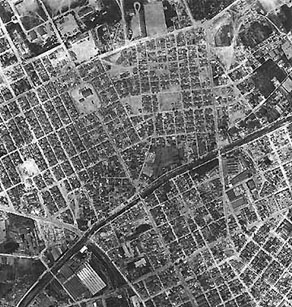Design Studio Required Elective at semester(s) 6, 8, ECTS: 12
Αεροφωτογραφία της Νέας Ιωνίας, 1955.
Γεωγραφική Υπηρεσία Στρατού, Χαστάογλου, Βόλος, Πορτρέτο, σ. 85.
Analysis, Synthesis
This course seeks to give students the necessary tools for understanding a different architectural language and how this coexists with contemporary urban city. This goal will be attained through the study and deep understanding of the "grounds", meaning the public, private and communal spaces in Nea Ionia, a region of different scale within the structure of the city of Volos. Every student is then asked to create his / her own proposal about the continuity and coexistence of this architectural language within the modern city, experimenting with different uses of scales.
Students are expected to develop a familiarity with the characteristics of Nea Ionia and to invent their own tools for the following purposes: a. understanding the relationship between public and private space, as opposed to communal space, which expresses the need for collective and individual participation; b. examining the relationship between natural and artificial landscapes; c. seeing the relationship between elements of a vernacular architecture and modern life. Students will trace the architectural thread of the area, create maps, interview, and understand the "grounds" of different materials, ground levels, spaces and their use. They will deal with the relationship between theory and design through an interpretation of architecture derived from the vernacular structures and all the fragments and traces that make up the culture of a city.
This course of architectural design is based on the understanding and interpretation of the architectural language of Nea Ionia, a region originally created to accommodate refugees and immigrants in the beginning of the twentieth century. A more descriptive title would be "The scale of the vernacular architecture in the contemporary structure of the city." In order to be fully understood, the architectural language of a region must have the following characteristics: it must be common, meet the needs of people, describe their culture, it must know where it is addressed and what it really wants to say. This understanding will be implemented in Nea Ionia, an area where part of it is with particular characteristics such as small plots of land and houses, and community spaces as places of memory and tradition. The course consists of four different assignments designed to enable students to explore and understand the area, to imagine, and create proposals that will benefit communal life.
